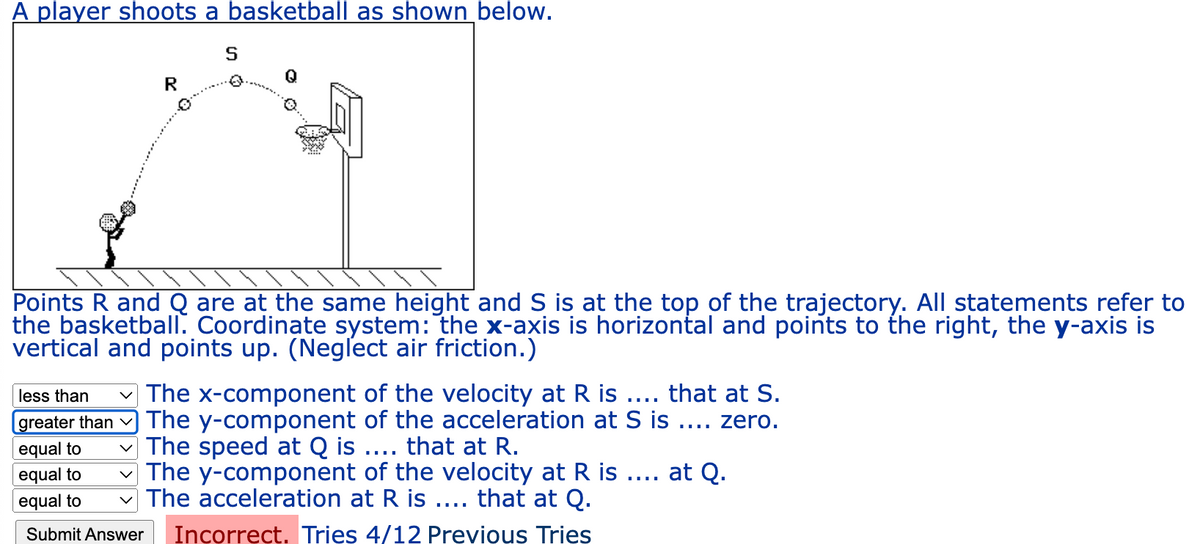A player shoots a basketball as shown below. R S Q Points R and Q are at the same height and S is at the top of the trajectory. All statements refer to the basketball. Coordinate system: the x-axis is horizontal and points to the right, the y-axis is vertical and points up. (Neglect air friction.) less than ✓ The x-component of the velocity at R is .... that at S. greater than The y-component of the acceleration at S is .... zero. equal to The speed at Q is .... that at R. equal to equal to ✓ The y-component of the velocity at R is The acceleration at R is .... that at Q. …….. at Q.
A player shoots a basketball as shown below. R S Q Points R and Q are at the same height and S is at the top of the trajectory. All statements refer to the basketball. Coordinate system: the x-axis is horizontal and points to the right, the y-axis is vertical and points up. (Neglect air friction.) less than ✓ The x-component of the velocity at R is .... that at S. greater than The y-component of the acceleration at S is .... zero. equal to The speed at Q is .... that at R. equal to equal to ✓ The y-component of the velocity at R is The acceleration at R is .... that at Q. …….. at Q.
University Physics Volume 1
18th Edition
ISBN:9781938168277
Author:William Moebs, Samuel J. Ling, Jeff Sanny
Publisher:William Moebs, Samuel J. Ling, Jeff Sanny
Chapter4: Motion In Two And Three Dimensions
Section: Chapter Questions
Problem 56P: Olympus Mons on Mars is the largest volcano in the solar system, at a height of 25 km and with a...
Related questions
Question

Transcribed Image Text:A player shoots a basketball as shown below.
R
S
Points R and Q are at the same height and S is at the top of the trajectory. All statements refer to
the basketball. Coordinate system: the x-axis is horizontal and points to the right, the y-axis is
vertical and points up. (Neglect air friction.)
less than ✓ The x-component of the velocity at R is .... that at S.
[greater than The y-component of the acceleration at S is .... zero.
equal to
The speed at Q is .... that at R.
at Q.
equal to
equal to
The y-component of the velocity at R is
The acceleration at R is .... that at Q.
Submit Answer Incorrect. Tries 4/12 Previous Tries
Expert Solution
This question has been solved!
Explore an expertly crafted, step-by-step solution for a thorough understanding of key concepts.
This is a popular solution!
Trending now
This is a popular solution!
Step by step
Solved in 2 steps with 2 images

Knowledge Booster
Learn more about
Need a deep-dive on the concept behind this application? Look no further. Learn more about this topic, physics and related others by exploring similar questions and additional content below.Recommended textbooks for you

University Physics Volume 1
Physics
ISBN:
9781938168277
Author:
William Moebs, Samuel J. Ling, Jeff Sanny
Publisher:
OpenStax - Rice University

Classical Dynamics of Particles and Systems
Physics
ISBN:
9780534408961
Author:
Stephen T. Thornton, Jerry B. Marion
Publisher:
Cengage Learning

College Physics
Physics
ISBN:
9781305952300
Author:
Raymond A. Serway, Chris Vuille
Publisher:
Cengage Learning

University Physics Volume 1
Physics
ISBN:
9781938168277
Author:
William Moebs, Samuel J. Ling, Jeff Sanny
Publisher:
OpenStax - Rice University

Classical Dynamics of Particles and Systems
Physics
ISBN:
9780534408961
Author:
Stephen T. Thornton, Jerry B. Marion
Publisher:
Cengage Learning

College Physics
Physics
ISBN:
9781305952300
Author:
Raymond A. Serway, Chris Vuille
Publisher:
Cengage Learning

Principles of Physics: A Calculus-Based Text
Physics
ISBN:
9781133104261
Author:
Raymond A. Serway, John W. Jewett
Publisher:
Cengage Learning